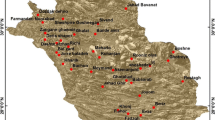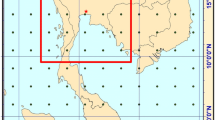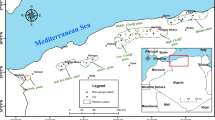Abstract
Determining the quantitative occurrence of droughts, discovering the spatial correlation of droughts, and predicting the occurrence of undesirable classes of drinking water quality and aquifer farming is of high importance. In this research, the Standardized Precipitation Index (SPI) was calculated and analyzed with a monthly survey of 26,027 wells in 609 study areas over a period of 20 years. After analyzing the missing data, the annual rainfall was forecasted in 362 synoptic stations of the country based on an artificial intelligence model. In addition, statistical relationships were extracted in order to achieve a comprehensive and historical map of the state of shortages and surpluses of water resources, as well as verification of artificial intelligence relationships in predicting base data cultivars. The results indicated that the “mild drought” indicator was steeper than the “near-normal drought” indicator. Eventually, the southern and eastern regions and certain parts of the northeast of the country in the period from 2005 to 2015 were placed in the 7th and 8th classes, which indicates severe drought. The analysis of the period 1994–2014 showed that the plains of the Sistan and Baluchestan Province in the south-east region of the country have been significantly more affected by the droughts. With the exception of the central parts of Khorasan, the general eastern, southeast, and southern regions of the country can be considered as an absolute drought class for the long term.


































Similar content being viewed by others
References
Basirati M, Jokar MRA, Hassannayebi E (2019) Bi-objective optimization approaches to many-to-many hub location routing with distance balancing and hard time window Neural Computing and Applications:1–22
Bhuiyan C (2004a) Various drought indices for monitoring drought condition in Aravalli terrain of India. In, 2004. pp 12–23
Bhuiyan C (2004b) Various drought indices for monitoring drought condition in Aravalli terrain of India. In: XXth ISPRS Congress, Istanbul, Turkey, pp 12–23
Brekhovskikh V, Volkova Z, Lomova D (2009) Assessment of water quality in the rivers of northern European Russia by using oxygen demand indices. Russ Meteorol Hydrol 34:321–330
Castellvı F, Mormeneo I, Perez P (2004) Generation of daily amounts of precipitation from standard climatic data: a case study for Argentina. J Hydrol 289:286–302
da Silva VDPR (2004) On climate variability in northeast of Brazil. J Arid Environ 58:575–596
Edwards DC (1997) Characteristics of 20th century drought in the United States at multiple time scales. AIR FORCE INST OF TECH WRIGHT-PATTERSON AFB OH,
Ferral A, Solis V, Frery A, Orueta A, Bernasconi I, Bresciano J, Scavuzzo CM (2017) Spatio-temporal changes in water quality in an eutrophic lake with artificial aeration. J Water Land Dev 35:27–40
Fu J-C, Huang H-Y, Jang J-H, Huang P-H (2019) River stage forecasting using multiple additive regression trees. Water Resour Manag 33:4491–4507
Guttman NB (1999) Accepting the standardized precipitation index: a calculation algorithm. JAWRA J Am Water Resour Assoc 35:311–322
Keyantash J, Dracup JA (2002) The quantification of drought: an evaluation of drought indices. Bull Am Meteorol Soc 83:1167–1180
Khuram I, Barinova S, Ahmad N, Ullah A, Din SU, Jan S, Hamayun M (2017) Ecological assessment of water quality in the Kabul River, Pakistan, using statistical methods. Oceanol Hydrobiol Stud 46:140–153
Kohzadi N, Boyd MS, Kaastra I, Kermanshahi BS, Scuse D (1995) Neural networks for forecasting: an introduction. Can J Agric Econ/Revue canadienne d'agroeconomie 43:463–474
Lana X, Serra C, Burgueño A (2001) Patterns of monthly rainfall shortage and excess in terms of the standardized precipitation index for Catalonia (NE Spain). Int J Climatol 21:1669–1691
LeCun Y, Bengio Y, Hinton G (2015) Deep learning. Nature 521:436–444
Li Y, Fu Y, Li H, Zhang S-W (2009) The improved training algorithm of back propagation neural network with self-adaptive learning rate. In: Computational Intelligence and Natural Computing,. CINC'09. International Conference on, 2009. IEEE, pp 73–76
Lloyd-Hughes B, Saunders MA (2002) A drought climatology for Europe. Int J Climatol 22:1571–1592
Mendicino G, Senatore A, Versace P (2008) A groundwater resource index (GRI) for drought monitoring and forecasting in a mediterranean climate. J Hydrol 357:282–302
Mishra AK, Singh VP (2010) A review of drought concepts. J Hydrol 391:202–216
Nielsen MA (2015) Neural networks and deep learning vol 2018. Determination press San Francisco, CA, USA
Schmidhuber J (2015) Deep learning in neural networks: an overview. Neural Netw 61:85–117
Schoof J (2008) Application of the multivariate spectral weather generator to the contiguous United States. Agric For Meteorol 148:517–521
Shirisha P, Reddy KV, Pratap D (2019) Real-time flow forecasting in a watershed using rainfall forecasting model and updating model. Water Resour Manag 33:4799–4820
Shoji T, Kitaura H (2006) Statistical and geostatistical analysis of rainfall in Central Japan. Comput Geosci 32:1007–1024
Tabari H, Nikbakht J, Talaee PH (2013) Hydrological drought assessment in northwestern Iran based on streamflow drought index (SDI). Water Resour Manag 27:137–151
Tigkas D, Vangelis H, Tsakiris G (2015) DrinC: a software for drought analysis based on drought indices. Earth Sci Inf 8:697–709
Tsakiris G, Pangalou D, Vangelis H (2007) Regional drought assessment based on the reconnaissance drought index (RDI). Water Resour Manag 21:821–833
Vlček O, Huth R (2009) Is daily precipitation gamma-distributed?: adverse effects of an incorrect use of the Kolmogorov–Smirnov test. Atmos Res 93:759–766
Wu H, Svoboda MD, Hayes MJ, Wilhite DA, Wen F (2007) Appropriate application of the standardized precipitation index in arid locations and dry seasons. Int J Climatol 27:65–79
Zhang G, Patuwo BE, Hu MY (1998) Forecasting with artificial neural networks:: the state of the art. Int J Forecast 14:35–62
Author information
Authors and Affiliations
Corresponding author
Ethics declarations
Conflict of Interest
No potential conflict of interest was reported by the authors.
Additional information
Publisher’s Note
Springer Nature remains neutral with regard to jurisdictional claims in published maps and institutional affiliations.
Rights and permissions
About this article
Cite this article
Azimi, S., Azhdary Moghaddam, M. Modeling Short Term Rainfall Forecast Using Neural Networks, and Gaussian Process Classification Based on the SPI Drought Index. Water Resour Manage 34, 1369–1405 (2020). https://doi.org/10.1007/s11269-020-02507-6
Received:
Accepted:
Published:
Issue Date:
DOI: https://doi.org/10.1007/s11269-020-02507-6




